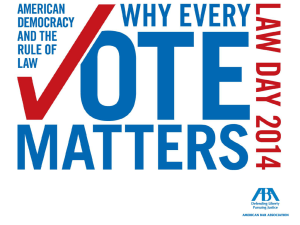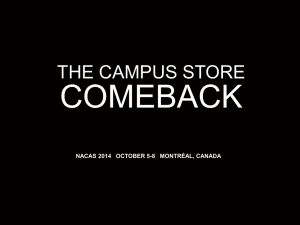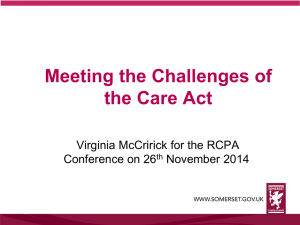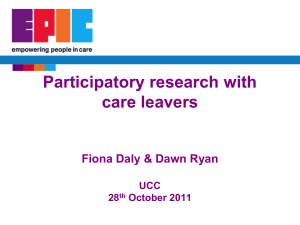Pre-Implementation Statistical Analysis Initiating a
advertisement
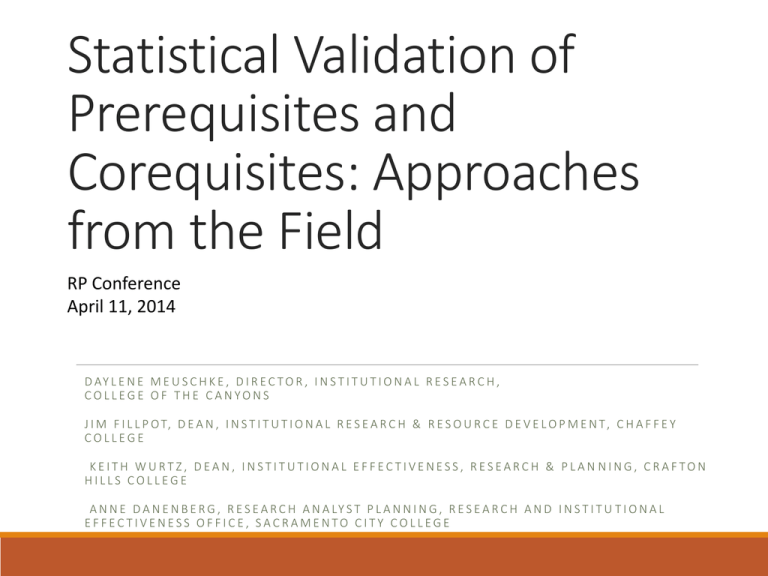
Statistical Validation of Prerequisites and Corequisites: Approaches from the Field RP Conference April 11, 2014 D AY L E N E M E U S C H K E , D I R E C T O R , I N S T I T U T I O N A L R E S E A R C H , COLLEGE OF THE CANYONS J I M F I L L P O T, D E A N , I N S T I T U T I O N A L R E S E A R C H & R E S O U R C E D E V E L O P M E N T , C H A F F E Y COLLEGE KEITH WURTZ, DEAN, INSTITUTIONAL EFFECTIVENESS, RESEARCH & PLAN NING, CRAFTON HILLS COLLEGE A N N E D A N E N B E R G , R E S E A R C H A N A LY S T P L A N N I N G , R E S E A R C H A N D I N S T I T U T I O N A L EFFECTIVENESS OFFICE, SACRAMENTO CITY COLLEGE Session Objectives Briefly review the Suggestions for CCC institutional Researchers Conducting Prerequisite Research Review approaches for locally validating prerequisites preimplementation and post-implementation ◦ Research methodologies ◦ Data sources ◦ Statistical techniques Provide strategies for communicating prerequisite findings to internal audiences and facilitating evidence-based decision making Overview of the Prerequisite Validation Guidelines Intended to help researchers ◦ Execute the statistical analyses ◦ Support faculty Developed by the RP Group with input from the field Input provided by various groups: matriculation, faculty, researchers Incorporated information from Academic Senate and Chancellor’s office guidelines The Prerequisite Research Framework Post-Implementation Pre-Implementation Content Analysis The “Warm Up” (a.k.a. Preliminary Work) Content Review/Validity (Pre-Implementation) ◦ ◦ ◦ ◦ ◦ Develop a systematic but manageable approach Researchers can help facilitate, if needed Identify what is acceptable level of success Ensure faculty have sufficient experience with the pre-requisite and target courses Consider using a rating template Content Review: Sample Rating Template Skill: Ability to… #1 #2 Rater #3 #4 Skill 1: Solve radical, 4 3 4 4 quadratic equations. Skill 2: Solve logarithmic 4 4 5 4 equations. Skill 3: Solve Number exponential of skills with3 a mean 4 rating 4 of ≥ 4.0: 5 4 equations. Skill 4: Solve Percent a varietyofofskills with a mean rating of ≥ 4.0: 80% problems by applying the 5 4 4 3 definitions, postulates and theorems of plane geometry. Skill 5: Graph linear, quadratic, simple polynomial, 5 4 5 4 exponential logarithmic functions and conic sections. #5 Mean Rating 4 3.8 5 4.4 4 4.0 5 4.2 4 4.4 The “Warm Up” (a.k.a. Preliminary Work) Preliminary Analyses (Pre-Implementation) ◦ Is the pre-requisite reasonably likely to improve student success? ◦ What enrollment/access issues might arise? ◦ What impact might this have on other programs? Information researchers need from faculty ◦ Changes in curriculum ◦ Inclusion/exclusion of different delivery modes ◦ Outcome measures Pre-Implementation Statistical Analysis Initiating a Statistical Validation Request Local Discussion Among: ◦ ◦ ◦ ◦ ◦ Discipline Faculty Faculty from Prerequisite Discipline Student Services (Matriculation) Personnel Curriculum Committee Administration •Knowing What the Process Entails •Institutionally Approved Requestor/Process ◦ Curriculum Committee ◦ Approved Research Request Form with Appropriate Sign-Off Some Useful Data Elements for Statistical Validation of Prerequisites MIS Data Elements ◦ GI03 (Term Identifier) ◦ CB01 (Course-Department-Number) ◦ SX01 (Enrollment-Effective-Date) ◦ SX04 (Enrollment-Grade) ◦ SB, SD, STD Data Elements (for Disproportionate Impact) Assessment Data ◦ Placement Recommendation (Communication and Computational Skills Courses) Sample Statistical Options for Researchers Test Questions Answered with Prerequisite Validation Approach T-Test Is their a statistically significant difference between the average GPA/success rate in the prerequisite and target courses? The observed difference may not be substantial. Chi-Square Is there a statistically significant difference between GPA in the target course and completion of the prerequisite course? The observed difference may not be substantial. Pearson Correlation Is there a significant relationship between GPA in the prerequisite and target courses? Sample Statistical Options for Researchers Test Questions Answered with Prerequisite Validation Approach Odds Ratio How likely is it that students who meet the prerequisite will succeed in the target course compared to those who do not meet the prerequisite? Effect Size What is the strength of the relationship between successfully completing the prerequisite course and successfully completing the target course? Average Percent Gain What is the average percent gain in success in the target course of students who met the prerequisite over those who did not meet the prerequisite? Chaffey College Prerequisite Validation Approach Three-Pronged Approach: 1. Comparison of Performance in the Target Course of Students Who Did and Did Not Meet the Prerequisite 2. Effect Size (accounts for influence of sample size) and Average Percent Gain 3. Restricted Bivariate Correlation Coefficient and Corrections for Restriction of Range ◦ Pearson’s r (Rule of Thumb: r ≥ .35, assuming p < .05) ◦ Chaffey also recalculates to correct for restriction of range Chaffey College Prerequisite Data Table Examination of Disproportionate Impact Prior to Prerequisite Enforcement Disproportionate impact occurs when “the percentage of persons from a particular racial, ethnic, gender, age or disability group who are directed to a particular service or placement based on an assessment instrument, method, or procedure is significantly different from the representation of that group in the population of persons being assessed, and that discrepancy is not justified by empirical evidence demonstrating that the assessment instrument, method or procedure is a valid and reliable predictor of performance in the relevant educational setting.” [Title 5 Section 55502(d)] When there is a disproportionate impact on any such group of students, the district shall, in consultation with the Chancellor, develop and implement a plan setting forth the steps the district will take to correct the disproportionate impact.” [Title 5 Section 55512(a)] Disproportionate Impact Guide (CCCCO and RP Group, 2013) Examination of Disproportionate Impact Prior to Prerequisite Enforcement Classification and Regression Trees (CART) ◦ divide a population into segments that differ with respect to a designated criterion. ◦ identifies the best predictor variable, conducting a splitting algorithm that further identifies additional statistically significant predictor variables and splits these variables into smaller subgroups ◦ ensures that cases in the same segment are homogeneous with respect to the segmentation criterion, while cases in different segments tend to be heterogeneous with respect to the segmentation criterion Classification and Regression Tree (CART) Example Tree Chaffey College Decision to Implement a Prerequisite Green – Sufficient evidence exists to enforce prerequisite (at least two out of three measures are supported) Yellow – Although evidence exists, only one out of three measures supports enforcement of the prerequisite. Further discussion should occur within the department and the Curriculum Committee before the prerequisite is enforced Red – Data does not exist to support enforcement of the prerequisite. None of the measures explored meet preestablished criteria Insufficient Data – While evidence may point to the efficacy of the prerequisite, the sample size is too small to render a reliable decision Post-Implementation Statistical Analysis Post-Implementation Statistical Analysis: Research Questions The following questions were examined to determine the impact of implementing READ-078 as a prerequisite for EMS-020: ◦ Did the EMS-020 course success rate increase after the READ-078 prerequisite was implemented? ◦ What is the racial/age/gender/disability makeup of the course post implementation compared to pre implementation? ◦ Does the increased success of students in each protected category support the implementation if indeed the percentages of students in each group have changed? ◦ Was there disproportionate impact? ◦ What effect did the implementation have on overall course enrollment? Post-Implementation Statistical Analysis: Methodology An effect size statistic was used to indicate the size of the difference between course success for students who met and did not meet the prerequisite At the time of the study the prerequisite had been enforced from Spring 2011 to Spring 2013 (i.e. 5 primary terms) The performance of students who had to meet the prerequisite prior to taking EMS-020 was compared to students who earned a GOR in EMS020 from Fall 2008 to Fall 2010 Post-Implementation Statistical Analysis: Findings 1. Did the EMS-020 course success rate increase after the READ-078 prerequisite was implemented? a. Yes, students who met the reading prerequisite were statistically significantly (p < .001) and substantially (ES = .21) more likely to successfully complete EMS-020 (62%) than students who had not completed the prerequisite (51%). Success Rate Course PreImplementation # EMS-020 440 N % PostImplementation # 857 51.3 349 N % ES P Value 565 61.8 .21 < .001 Post-Implementation Statistical Analysis: Findings 2. What is the racial/age/gender/disability makeup of the course post implementation compared to pre implementation? a. Gender, ethnicity, age, and disability status were not substantially different prior to or after the implementation of the READ-078 prerequisite. Gender Female Male Unknown Total Pre-Implementation # N 142 16.6 710 82.8 5 0.6 857 100.0 Post-Implementation % # 103 18.2 462 81.8 0 0.0 565 100.0 Total N 245 1,172 5 1,422 % 17.2 82.4 0.4 100.0 Post-Implementation Statistical Analysis: Findings To identify disproportionate impact can use the 80% rule or segmentation modeling (see page 17 in Wurtz & Riggs, 2010 for an example of segmentation modeling). 80% Rule .80 * .828 (proportion of males pre-implementation) = .6624 or 66.2%. Is the proportion of males less than 66.2% post-implementation? .80 * .166 (proportion of females pre-implementation) = .1328 or 13.3%. Is the proportion of females less than 13.3% post-implementation? Gender Female Male Unknown Total Pre-Implementation # N 142 16.6 710 82.8 5 0.6 857 100.0 Post-Implementation % # 103 18.2 462 81.8 0 0.0 565 100.0 Total N 245 1,172 5 1,422 % 17.2 82.4 0.4 100.0 Post-Implementation Statistical Analysis: Findings 3. Does the increased success of students in each protected category support the implementation, if indeed the percentages of students in each group have changed? a. b. Yes, male students, Hispanic Students, and students 24 years old or younger were substantially (ES >= .20) and statistically significantly (p < .01) more likely to successfully complete EMS-020 if they had met the reading prerequisite than students who had not met the prerequisite. In addition, female, African American, and Native American students were slightly more likely to successfully complete EMS-020 post-implementation. Ethnicity Asian African American Hispanic Native American Caucasian Unknown Total Success Rate Pre-Implementation Post-Implementation # N % # N % 11 22 50.0 11 24 45.8 30 57 52.6 14 26 53.8 116 304 38.2 121 211 57.3 14 24 58.3 9 14 64.3 258 429 60.1 191 286 66.8 11 21 52.4 3 4 75.0 440 857 51.3 349 565 61.8 ES -.08 .02 .39 .12 .14 .44 .21 P Value .783 .919 < .001 .726 .070 .425 < .001 Post-Implementation Statistical Analysis: Findings 4. Was there disproportionate impact? ◦ Used Classification and Regression Tree (CART) modeling to analyze disproportionate impact by gender, ethnicity, age, and disability status Post-Implementation Statistical Analysis: Findings 5. What effect did the implementation have on overall course enrollment? ◦ The overall course enrollment in EMS-020 did not decrease as a result of the implementation of the prerequisite ◦ The decline in enrollments and section offerings was due to the statewide budget cuts and comparable to the cuts that occurred college wide. Section 1 2 3 4 5 6 Total Fall 2008 40 40 39 40 37 33 229 Pre-Implementation Spring Fall Spring 2009 2009 2010 40 40 40 39 42 30 45 37 41 36 41 41 35 0 0 0 0 0 195 160 152 Fall 2010 42 43 36 0 0 0 121 Spring 2011 39 38 43 0 0 0 120 Post-Implementation Fall Spring Fall 2011 2012 2012 39 43 39 37 39 37 40 35 29 0 0 0 0 0 0 0 0 0 116 117 105 Spring 2013 42 42 23 0 0 0 107 Sacramento City College Example History Department, 2011—2014 17 courses 40-50 sections per semester offered pre-implementation, with 2,300 to 2,700 Census enrollments from 2009-2011 Studied largest-enrolled (U.S. HIST) courses based on Fall 2009 HIST enrollments and prior English preparation. A department-wide pre-req. of English 1-level-below-transfer was implemented in Fall 2012, based on a number of factors, including: Same SLOs for all SCC HIST courses Same minimum writing word count requirement for all SCC HIST courses Sacramento City College Example (continued…) Enrollment impact estimation=16% (based on 2009 data) Able to calibrate estimates against actuals to inform planning for other departments. How close were we? From Fall 2011 to Fall 2012 = 16.37% No measurable change is success rates How does enrollment composition look? SCC Example (continued…) Now that prerequisite has been in place for 3 semesters… SCC History Department Fall and Spring Fill Rate (Fall 2004 to Fall 2013) 120.0 99.8 100.0 89.9 86.1 83.0 80.0 Percentage 60.0 40.0 20.0 0.0 Fall 2012: Pre-requisite implementation SCC Example (continued…) Ethnicity before and after prerequisite 35 30 25 African American Asian Filipino 20 Latino MultiNative American 15 Other, non-wht Pacific Islander Unknown 10 White 5 0 Fall 2009 Spring 2010 Fall 2010 Spring 2011 Fall 2011 Spring 2012 Fall 2012 Communicating Results and Evidence-Based Decision Making Tips for Communicating Prerequisite Results Affirm your common interest in supporting and enhancing student success Affirm that you are there to support and assist faculty Affirm that the research is not meant to substitute for faculty’s professional judgment (i.e. evidence-based decision making) Making data accessible (i.e. do not use big statistical term, know your audience) Recognize and communicate the limitations of the data/research in the beginning Consider different approaches for how data is presented Questions Resources: College Examples Cabrillo College ◦ Cabrillo College. (2002). Validation of English 1A as a prerequisite for Psychology 1A. Aptos, CA: Borden, R. C. Chaffey College ◦ Chaffey College. (2011). Prerequisite Validation Studies: Impact of a Reading Prerequisite on HIST-1, HIST-2, and HIST-7. Rancho Cucamonga, CA: Institutional Research ◦ Chaffey College. (2010). Philosophy 76 Prerequisite Validation Study: English 1A Prerequisite. Rancho Cucamonga, CA: Institutional Research. Sacramento City College ◦ Danenberg, A. (2011). Methodological and Data Considerations for a Communication or Computation Prerequisite Implementation Study. Sacramento City College: Planning, Research, & Institutional Effectiveness. Crafton Hills ◦ Wurtz, K. A. (2014). Relationship of the EMS-020 Reading Prerequisite to EMS-020 Course Success. Retrieved March 25, 2014 from http://www.craftonhills.edu/~/media/Files/SBCCD/CHC/About%20CHC/Research%20and%20Planning/Research%20 Briefs/Academic%20Success%20Studies/2013_July_EMS20_PrereqEval_Post2.pdf ◦ Wurtz, K. A., & Riggs, M. (2010). Prerequisite Validation Study: Examination of Reading as a Prerequisite to EMS-020 (Emergency Medication Technician-I / EMT – Basic). Retrieved November 16, 2012 from http://www.craftonhills.edu/~/media/Files/SBCCD/CHC/About%20CHC/Research%20and%20Planning/Research%20 Reports/0910_EMS_Read_PrerequisiteStudy.ashx RP Group for California Community Colleges ◦ RP Group. (2013). SUGGESTIONS FOR CALIFORNIA COMMUNITY COLLEGE INSTITUTIONAL RESEARCHERS CONDUCTING PREREQUISITE RESEARCH. Retrieved March 25, 2014 from http://www.rpgroup.org/sites/default/files/RPGroupPreqreqGuidelinesFNL.pdf


